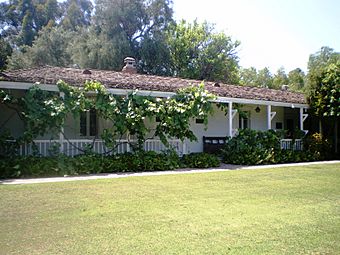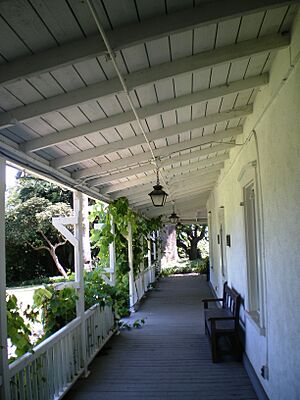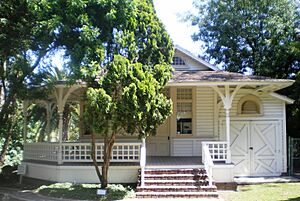Centinela Adobe facts for kids
Quick facts for kids |
|
|
Centinela Adobe
|
|

The Centinela Adobe
|
|
| Location | 7634 Midfield Ave Westchester, Los Angeles, California |
|---|---|
| Built | 1834 |
| Architect | Ygnacio Machado |
| Architectural style | Spanish Colonial-Adobe |
| NRHP reference No. | 74000522 |
| Added to NRHP | May 2, 1974 |
The Centinela Adobe, also known as La Casa de la Centinela, is an old house in Westchester, Los Angeles, California. It was built in 1834. This house is made of adobe, which is a type of sun-dried brick. Today, it is a house museum run by the Historical Society of Centinela Valley. It's one of only 43 adobe houses still standing in Los Angeles County, California.
The Centinela Adobe was once the main building of a huge ranch called the Rancho Aguaje de la Centinela. This ranch was about 25,000 acres (100 square kilometers) big! It was part of a larger land grant from the Mexican era. The Centinela Adobe is the oldest home in the Centinela Valley area. It has been called the "Birthplace of Inglewood." Many different people have lived in the house, including farmers, ranchers, and even Daniel Freeman, who helped start the city of Inglewood.
History of the Centinela Adobe Ranch
Early Land Grants in California
After Mexico won its freedom from Spain in 1821, it began giving out large pieces of land. These were called "land grants." In 1822, a man named Antonio Ygnacio Avila received a land grant for a huge area called Rancho Sausal Redondo. He used this land to raise cattle.
This rancho covered a very large area. Today, it includes cities like Redondo Beach, Inglewood, Hawthorne, El Segundo, Lawndale, Manhattan Beach, and Hermosa Beach.
Ygnacio Machado and the Adobe's Beginning
In the early 1830s, Ygnacio Machado started farming a part of the Rancho Sausal Redondo. Ygnacio Machado was the son of one of the soldiers who helped settle Los Angeles. His brother, Augustin Machado, owned other large ranches nearby.
Ygnacio Machado received his own land grant, a 2,220-acre (9 square kilometer) area called the Rancho Aguaje de la Centinela. He built the Centinela Adobe in 1834. The original house was made of adobe bricks on a stone base. Later, wooden parts were added. Ygnacio Machado only owned the rancho for a short time. In 1844, he traded it for a small house and some whiskey in the old Pueblo de Los Angeles.
New Owners and a Growing Ranch
The rancho changed hands several times in the 1850s. In 1860, a Scotsman named Robert Burnett bought the rancho for $3,000. Burnett made the ranch even bigger by buying the old Rancho Sausal Redondo. By 1872, Burnett owned a massive 25,000-acre (100 square kilometer) ranch. This huge property stretched from what is now Playa del Rey all the way to Lawndale and Redondo Beach.
Daniel Freeman and the Birth of Inglewood
In 1873, Robert Burnett returned to Scotland. He leased his large ranch to Daniel Freeman, who had just arrived from Simcoe, Ontario, Canada. Freeman paid $7,500 a year to rent the ranch. He also had the option to buy it later for $150,000.
Freeman started by raising sheep and planting many trees, including 7,000 orange trees and 2,000 almond trees. When a drought caused 22,000 of his sheep to die, Freeman switched to growing barley. He became very successful, producing a million barrels of barley each year.
In 1885, Freeman decided to buy the ranch for $140,000 in gold. He made a lot of money farming barley, olives, lemons, limes, and almonds. He named his large property "Inglewood" after his hometown in Canada.
In 1887, a railroad line was built to Redondo Beach. Freeman then started selling off parts of his ranch in smaller pieces. About 11,000 acres (45 square kilometers) were sold, and this area became the city of Inglewood. In 1888, Freeman built a large mansion in Inglewood. The next year, in 1889, he built a land office. This office is now located on the grounds of the Centinela Adobe. Over time, all 25,000 acres of the ranch were divided and sold. The only part of the original ranch that remains today is the 1-acre (4,000 square meter) site where the Centinela Adobe stands.
Centinela Adobe Museum Today
The Centinela Adobe Complex is seen as the historical heart of the Centinela Valley area. This area includes the lands from the Baldwin Hills to Palos Verdes.
Saving the Adobe from Demolition
In the late 1940s, the Centinela Adobe was almost torn down. The land around it was being divided to build new homes. But people who cared about history raised money to buy the property in 1950. They then gave it to the City of Inglewood. The city still takes care of the adobe through its Parks and Recreation Department.
The Centinela Adobe Complex, along with Daniel Freeman's old land office, is open for tours. These tours are led by special guides called docents.
Visiting the Adobe Museum
The adobe has been carefully restored. It is now run by the Historical Society of the Centinela Valley and the Inglewood Department of Parks and Recreation. The adobe and museum are located at 7634 Midfield Ave. This is a residential street right next to the 405 Freeway.
The museum is open on Sundays from 2 to 4 p.m. It is free to enter, and docents are there to give tours. If you have a group or a special event, you can call the Historical Society to arrange a tour at other times. The adobe is filled with furniture and items from the late 1800s.
In 2001, the Los Angeles Times newspaper wrote about the museum. They said the adobe looks like it's still in the 19th century. But then you see the nearby freeway, which shows it's a "time warp." It's a peaceful old home surrounded by modern city life.
Daniel Freeman's Land Office
The Freeman Land Office is also part of the tours. It was built in 1887 for the Centinela-Inglewood Land Company. Its original location was on Florence Avenue. This building was used to sell pieces of land for what became the city of Inglewood. The building has been moved twice. The last time was in 1975, when it was moved to its current spot next to the adobe. The land office building is well-preserved and has many old items and photographs inside.
Heritage and Research Center
The grounds also have a heritage and research center. This center opened in 1980. It holds items from Daniel Freeman's mansion, which was taken down in 1972. You can see Freeman's library, his safe, and some of his furniture. There are also articles and photos about the history of the Centinela Valley.
See also




